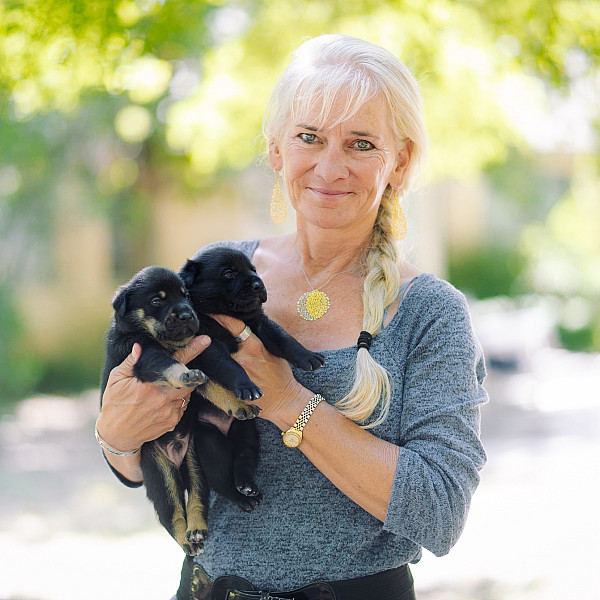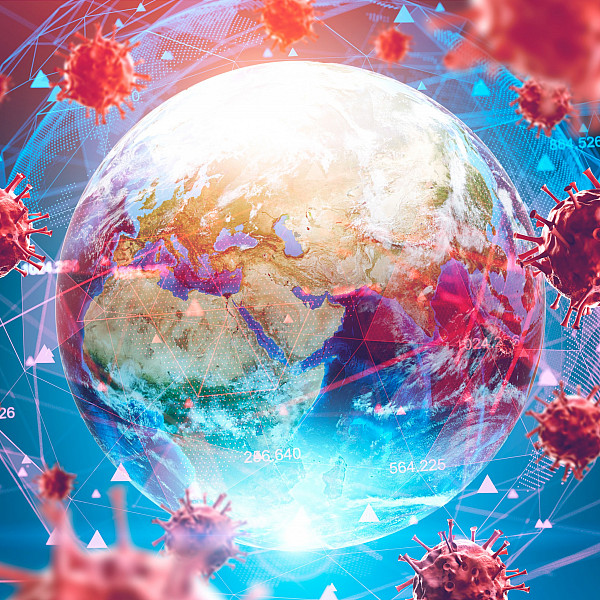News
Scholarly Perspectives on COVID-19, Part 8: Apocalypse or Dystopia?
January 14, 2021
January 14, 2021
This is the eighth story in a series on Southwestern faculty perspectives on severe acute respiratory syndrome coronavirus 2 (SARS-CoV-2) and coronavirus disease 2019 (COVID-19). Part 1 focused on biology, part 2 on mathematics, part 3 on economics, part 4 on sociology, part 5 on political science, part 6 on psychology, and part 7 on history.
By January 11, 2021, the global infection rate of coronavirus disease 2019 (COVID-19) had surged to nearly 91 million, with the death toll climbing to more than 1.94 million. In the U.S., cases topped 22.5 million, with deaths attributed to COVID-19 surpassing 375,000.
The numbers reveal how a pandemic can run rampant across a planet, how governmental leadership thrives or fails, how economies run aground or remain constant, how misinformation and lack of information literacy endanger communities, and how scientists collaborate to improve their knowledge of pathogens while racing to develop vaccines and treatments. But unless the pandemic has touched your life directly—beyond, of course, the ways that our work and social lives have been disrupted with remote work, distance learning, social distancing, mask wearing, and obsessive handwashing or use of hand sanitizer—it’s easy to become curiously indifferent to the statistics. Global-scale illness and death have a strange way of losing their meaning when conveyed only through numbers, and we can become numb to the suffering or bereavement of patients and survivors or the fatigue, anxiety, and depression of caretakers and essential workers.
Global-scale illness and death have a strange way of losing their meaning when conveyed only through numbers, and we can become numb to the suffering or bereavement of patients and survivors or the fatigue, anxiety, and depression of caretakers and essential workers.
One power of the humanities, however, lies in bringing the stories of those human experiences to the fore, renewing our empathy and shocking us out of apathy. Reading literature about a pandemic or watching films about a plague-induced apocalypse can bring meaning back to unfathomable numbers, help us reflect on our values, remind us to value our connections with others, and reveal the best—and worst—of humanity.
Apocalypse now (and then)
“The Apocalypse class is kind of made for this,” says Laura Hobgood. “It’s a fun class.”
The professor and Elizabeth Root Paden chair in religion and environmental studies taught her popular course last spring and again in fall 2020, with some tweaks inspired by the COVID-19 crisis. The syllabus begins with the Book of
Hobgood and her students also discuss apocalypse narratives through the lenses of environmentalism and politics. Fictional scenarios about the ultimate impacts of global climate change are on the syllabus, for example, and the class examines the inevitable criticisms that follow a federal election or occur during a national emergency. “With almost any president,” Hobgood shares, “there’s apocalyptic language by [the opposition] saying, ‘This president shouldn’t have been elected,’ ‘We’re never going to survive this president,’ … or ‘This is the worst possible president we could have during a crisis like this’”—all comments we have seen in response to the elections or administrations of George W. Bush, Barack Obama, Donald Trump, and Joe Biden. “But people would say that no matter who the president was,” Hobgood continues. “It’s interesting.”
The walking undead
In a particularly fraught year, it’s no surprise that race, class, and income inequalities have emerged as a significant focus of dialogue, particularly when the class discusses movies and novels depicting zombie apocalypses. So students have connected journalistic and scholarly analyses of the racial disparities in infection and mortality rates of COVID-19 with George A. Romero’s classic horror film Night of the Living Dead (1968) and Kira Jane Buxton’s Hollow Kingdom (2019), a book written from the point of view of a pet crow observing the plight of his beloved “MoFos,” or humans. “A lot of the narratives about zombies have to do with insiders and outsiders. It’s about shunning others, so it’s making others out of people, and the others are the zombies,” Hobgood shares. “But zombie narratives are also about the scary viruses that will kill you; there’s no cure for them, and you won’t get over them.” Not unlike real-life pandemics of the past and present, fictions of zombie contagion foreground our fears of decay and death, our tendency to segregate and dehumanize those who have fallen ill, and our hope of survival through cooperative action, information and resource sharing, and effective leadership.
Despite what one might expect given the topic, the Apocalypse course is not all gloom and doom; Hobgood and her students enjoy a lot of laughs and creative projects, too. The class has looked to representations of the end of the world in the board game Pandemic, in which players take on the roles of healthcare experts, researchers, and transportation specialists, cooperating to save humanity from an outbreak of a deadly global disease. During their end-of-semester “Artpocalypse,” students find and write an analysis of a piece of apocalypse-themed art or music—or make their own. And one assignment that truly captures the students’ imaginations is the construction of an apocalypse survival kit, in which they must decide what to include after considering basic needs and projected circumstances. “I have them fail if they don’t have duct tape in it,” Hobgood laughs. “But with this [pandemic], none of us thought about going out there and buying toilet paper, bleach, rubbing alcohol, [and] frozen foods!”
Future thinking
Given her research and teaching about apocalypse narratives, Hobgood believes that the public response to COVID-19 “was something we could have anticipated.” The runs on stores and the hoarding of food and supplies during the lockdowns of March and April 2020, for example, are “something that we do in any kind of disaster, like when we know a hurricane is coming,” she says. Such reactions elicited disappointment and criticism from many, but Hobgood has also found communities’ attempts at “not letting the virus spread quickly heartening.” Still other positive outcomes of the pandemic are tinged with sadness: it took K–12 schools and colleges moving to remote or hybrid learning, for instance, to decrease the number of school shootings in the U.S., which declined from 55 in 2019 to 8 in 2020, with zero mass school shootings during the pandemic so far. Such bittersweet observations are at the heart of the pandemic and apocalypse fictions that Hobgood and her students engage with in class but are also living through in real life.
Considering how many of the narratives Hobgood teaches envision the future, it’s perhaps inevitable that the professor wonders how such stories will change in coming decades—and how our lives will as well. “A couple years from now, maybe I’ll get students to do narratives about ‘before the novel coronavirus’ and ‘after the novel coronavirus,’” she suggests. After all, she says, the Depression and World War II shaped the way her own parents and an entire generation lived and thought, instilling such characteristics as frugality and self-reliance (e.g., by learning to grow and make their own food) to avoid a repeat of the privation they endured in the 1930s and 1940s. Similarly, says Hogbood, the COVID-19 pandemic “will really mark that the world changed—for all of us, but particularly for some younger people.” The latest coronavirus has already shifted how (and whether) we work, visit family, seek entertainment, and socialize; some of those changes, Hobgood believes, might continue after the pandemic ends: we might very well see post-2020 differences in how we celebrate holidays, such as New Year’s Eve on Times Square, or how religious communities gather and worship. And, she adds, “one of the most tragic parts of all this is that you can’t be with a loved one who’s dying, and you can’t mourn those who’ve died. I think we’re going to see the trauma of that playing out for a while, too.”
Although Hobgood explores such questions in her Apocalypse seminar, she believes the 2020 pandemic “doesn’t quite feel as much like an apocalypse as it does a dystopia.” Although the death tolls for COVID-19 are tragic, she explains, the proportion of the population who dies from the disease is still low compared with that of pandemics such as the 1918 flu or tuberculosis in the nineteenth century. And in fictional apocalypse narratives, entire global populations are wiped out, with only a few survivors (or one lone individual) remaining. Moreover, in those stories, Hobgood reminds us, good and hoped-for things can come from such dire events. At the conclusion of the Book of Revelations, for example, a new heaven and Earth emerges, which is why leaders such as Martin Luther King Jr. sometimes used images of apocalypse to foretell a better future after a traumatic crisis—a more just nation can grow from the pain of racism just as rebirth and renewal often follow death and destruction in folklore and mythology. Similarly, COVID-19 “is really showing how terribly broken our healthcare system is. Is fixing it some new normal that can be the good that comes out of this?” Hobgood asks. If so, perhaps reality can avoid the trappings of the dystopia that it currently seems to mirror.
Perhaps reality can avoid the trappings of the dystopia that it currently seems to mirror.
Whether they are mirrored by dystopian or apocalyptic novels or films, the graffiti of street artists, or religious beliefs about the world’s end, Hobgood will continue to read and think about the pandemic’s “real long-term impacts on society as a whole and how we’re going to be different,” she says. “That’s the thing that’s most intriguing right now: thinking of the before and after and what the societal changes are going to be.”
Further reading and viewing
Centers for Disease Control and Prevention, “Preparedness 101: Zombie Apocalypse”
Harvard T. H. Chan School of Public Health, Center for Climate, Health, and the Global Environment, “Coronavirus, Climate Change, and the Environment”
World Wildlife Fun, “COVID-19 and Wildlife Trade: Perspectives and Proposed Actions”
Emily Zarka and PBS, “The Origins of the Zombie, from Haiti to the U.S.,” Monstrum


















